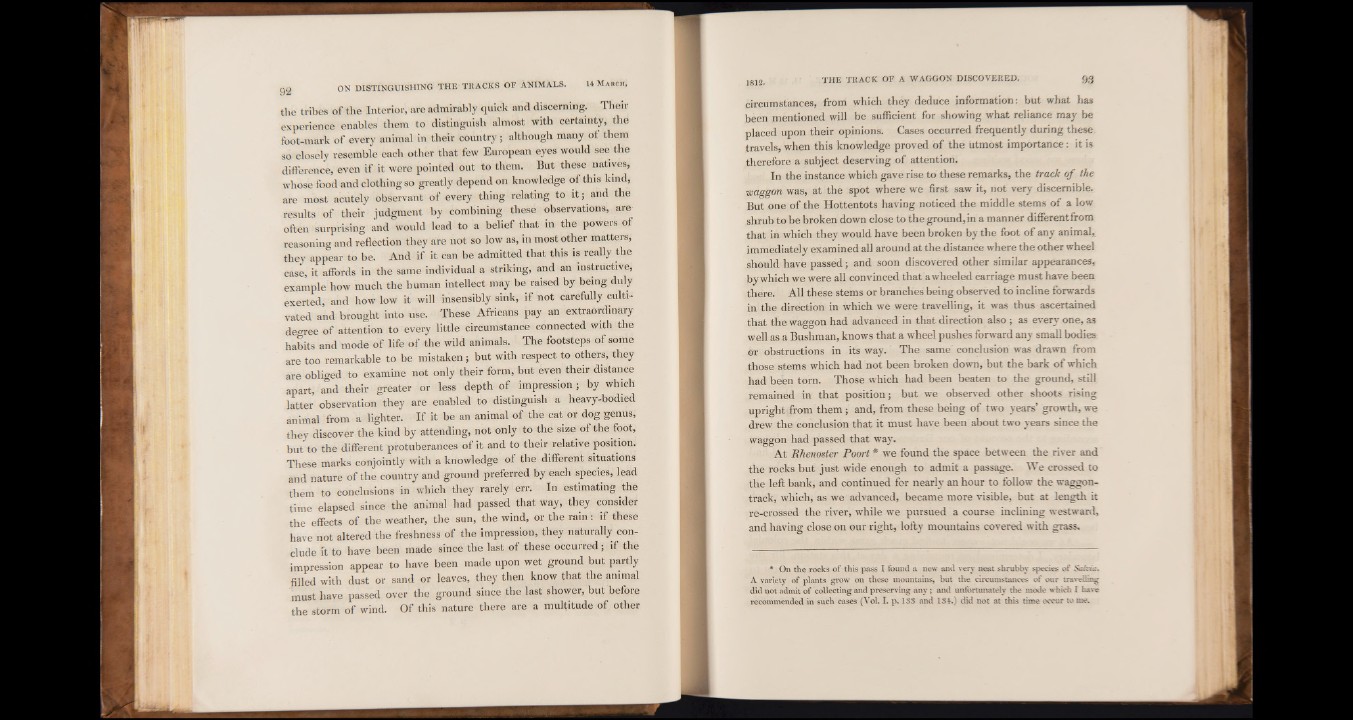
9 2 ON DISTINGUISHING THE TRACKS OF ANIMALS. M March,
the tribes of the Interior, are admirably quick and discerning. Their
experience enables them to distinguish almost with certainty, the
foot-mark of every animal in their country; although many of them
so closely resemble each other that few European eyes would see the
difference, even if it were pointed out to them. But these natives,
whose food and clothing so greatly depend on knowledge of this kind,
are most acutely observant of every thing relating to it; and the
results of their judgment by combining these observations, are
often surprising and would lead to a belief that in the powers of
reasoning and reflection they are not so low as, in most other matters,
they appear to be. And if it can be admitted that this is really the
case, it affords in the same individual a striking, and an instructive,
example how much the human intellect may be raised by being duly
exerted, and how low it will insensibly sink, if not carefully cultivated
and brought into use. These Africans pay an extraordinary
degree of attention to every little circumstance connected with the
habits and mode of life of the wild animals. The footsteps of some
are too remarkable to be mistaken ; but with respect to others, they
are obliged to examine not only their form, but even their distance
apart, and their greater or less depth of impression; by which
latter observation they are enabled to distinguish a heavy-bodied
animal from a lighter. If it be an animal of the cat or dog genus,
they discover the kind by attending, not only to the size of the foot,
but to the different protuberances of it and to their relative position.
These marks conjointly with a knowledge of the different situations
and nature of the country and ground preferred by each species, lead
them to conclusions in which they rarely err. In estimating the
time elapsed since the animal had passed that way, they consider
the effects of the weather, the sun, the wind, or the rain : if these
have not altered the freshness of the impression, they naturally conclude
it to have been made since the last of these occurred; if the
impression appear to have been made upon wet ground but partly
filled with dust or sand or leaves, they then know that the animal
must have passed over the ground since the last shower, but before
the storm of wind. Of this nature there are a multitude o f other
lgl2_ t h e t r a c k o f a w a g g o n d is c o v e r e d . 93
circumstances, from which they deduce information: but what has
been mentioned will be sufficient for showing what reliance may be
placed upon their opinions. Cases occurred frequently during these
travels, when this knowledge proved of the utmost importance: it is
therefore a subject deserving of attention.
In the instance which gave rise to these remarks, the track of the
waggon was, at the spot where we first saw it, not very discernible.
But one of the Hottentots having noticed the middle stems of a low
shrub to be broken down close to the ground, in a manner differentfrom
that in which they would have been broken by the foot of any animal,
immediately examined all around at the distance where the other wheel
should have passed; and soon discovered other similar appearances,
by which we were all convinced that a wheeled carriage must have been
there. All these stems or branches being observed to incline forwards
in the direction in which we were travelling, it was thus ascertained
that the waggon had advanced in that direction also; as every one, as
well as a Bushman, knows that a wheel pushes forward any small bodies
er obstructions in its way. The same conclusion was drawn from
those stems which had not been broken down, but the bark of which
had been torn. Those which had been beaten to the ground, still
remained in that position; but we observed other shoots rising
upright from them ; and, from these being of two years’ growth, we
drew the conclusion that it must have been about two years since the
waggon had passed that way.
At Rhenoster Poort * we found the space between the river and
the rocks but just wide enough to admit a passage. We crossed to
the left bank, and continued for nearly an hour to follow the waggon-
track, which, as we advanced, became more visible, but at length it
re-crossed the river, while we pursued a course inclining westward,
and having close on our right, lofty mountains covered with grass.
* On the rocks of this pass I found a new and very neat shrubby species of Sahta.
A variety of plants grow on these mountains, but the circumstances of our travelling
did not admit of collecting and preserving any ; and unfortunately the mode which I have
recommended in such cases (Vol. I. p. 133 and 134.) did not at this time occur to me.